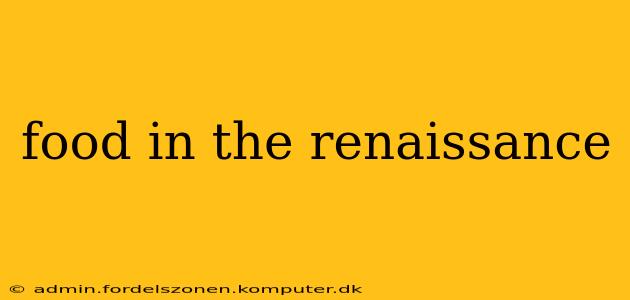The Renaissance, a period brimming with artistic and intellectual innovation, also saw significant changes in the way people ate. While the opulent feasts of the wealthy remain the most iconic image, understanding food in the Renaissance requires delving deeper than just lavish banquets. This exploration will uncover the diverse culinary landscape of the era, encompassing the rich and the poor, the regional variations, and the gradual shifts in dietary habits.
What did the rich eat in the Renaissance?
The wealthy elite of the Renaissance indulged in extravagant meals that showcased their power and status. These feasts were often elaborate affairs, featuring multiple courses of exotic and expensive ingredients. Think roasted peacock, spiced meats, sugared fruits, and elaborate pastries. Game, such as venison and boar, was highly prized, alongside fish, particularly during Lent. The use of spices like saffron, cloves, cinnamon, and ginger, imported from the East, was a hallmark of Renaissance cuisine, reflecting both the burgeoning spice trade and a desire for opulent flavor profiles. These feasts were not just about sustenance; they were carefully choreographed spectacles, emphasizing the social hierarchy and the host's generosity. The presentation of the food was as important as the food itself, with intricate arrangements and ornate serving dishes.
What did the poor eat in the Renaissance?
In stark contrast to the opulent feasts of the rich, the majority of the population, the peasantry and urban poor, relied on a much simpler diet. Their meals centered around grains like bread, barley, and oats; legumes such as beans and peas; and seasonal vegetables. Meat was a luxury they could rarely afford, consuming it perhaps only on special occasions. Dairy products, including cheese and milk, were also staples where available, along with fruits in season. Regional variations were significant; those living near the coast relied more heavily on fish, while those in inland areas depended on locally grown produce and grains. Food preservation techniques like salting, smoking, and pickling were crucial for ensuring a food supply throughout the year.
What were some common Renaissance recipes?
While precise recipes are scarce, we can glean an understanding of common Renaissance dishes from surviving cookbooks and historical accounts. Many dishes involved stews and pottages, often thickened with bread or grains. Roasted meats were popular, often seasoned with herbs and spices. Pastries, both sweet and savory, were also common, demonstrating advancements in baking techniques. The use of sugar, while still expensive, increasingly featured in both sweet and savory preparations. Remember, the availability of ingredients varied significantly based on location and season, leading to diverse regional cuisines.
What were the main ingredients used in Renaissance cooking?
The main ingredients used in Renaissance cooking varied significantly between the wealthy and the poor, as previously discussed. However, some common elements included grains (wheat, barley, rye, oats), legumes (beans, peas, lentils), vegetables (onions, garlic, cabbage, turnips, carrots), fruits (apples, pears, grapes, cherries), meats (beef, pork, mutton, poultry, game), fish, dairy products (cheese, milk, butter), eggs, and spices (salt, pepper, saffron, ginger, cinnamon, cloves). The availability of these ingredients was influenced by factors such as geography, climate, and economic conditions.
How did Renaissance food differ from Medieval food?
The Renaissance marked a gradual shift from the predominantly simple and utilitarian food of the Middle Ages. The increased trade and exploration during the Renaissance introduced new spices and ingredients from the East and the Americas, leading to a greater variety and complexity in dishes. The rise of humanist ideals also influenced cuisine, with a greater emphasis on aesthetics and the artistic presentation of food. While medieval meals were often simpler and focused on practicality, the Renaissance saw a growing interest in refined culinary techniques and more complex flavor combinations. However, it’s important to note that these changes were not uniform and were primarily experienced by the wealthy elite. The food of the common people continued to be largely based on seasonal availability and local ingredients.
How did Renaissance food influence modern cuisine?
The Renaissance's influence on modern cuisine is subtle yet significant. The increased use of spices and herbs, the development of more sophisticated cooking techniques, and the introduction of new ingredients all contributed to the evolution of European culinary traditions. Many of the basic principles of cooking that we still use today, such as the art of roasting, stewing, and baking, were refined and developed during this era. The legacy of the Renaissance is evident in the rich and varied culinary landscape of modern Europe and beyond.
This exploration provides a starting point for understanding the fascinating and complex world of food in the Renaissance. It's a world that reflects not only the tastes and preferences of the era but also its social structures, economic realities, and global connections. Further research into specific regions, social classes, and individual cookbooks can offer even richer insights into this captivating aspect of Renaissance history.
